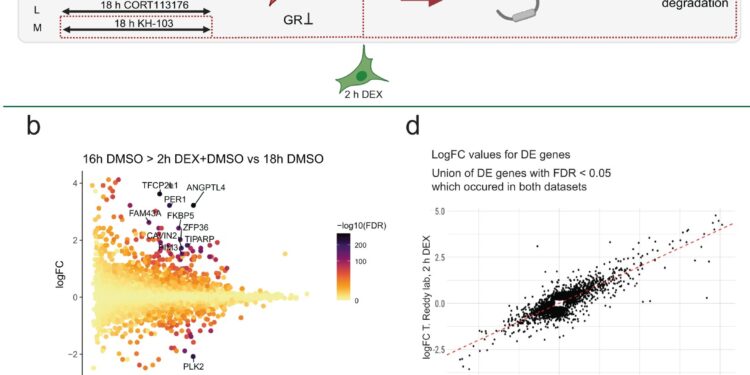The DEGs we identified after 2 h and 18 h DEX treatments in A549 cells align with other existing RNAseq and ChIP-seq datasets. Credit: Natural communications (2023). DOI: 10.1038/s41467-023-44031-2
Stress is not simply a feeling of oppression we feel when we are overwhelmed; it is the body’s natural reaction to acute or persistent tension. This stress response is what allows us to quickly adapt to danger or a change in conditions. But if this response, essential for survival, gets out of control and becomes a permanent state, it can trigger a whole series of negative effects: obesity, cardiovascular disease, increased susceptibility to infections, memory problems and loss of life. depression are all typical effects of chronic stress.
Until now, medical treatment has focused almost entirely on the symptoms of these secondary conditions. “The only approved drug that directly intervenes in the regulation of stress reactions has many unwanted side effects. It was actually developed as an abortive agent and its impact on stress is only a side effect,” explains Katharina Gapp , head of the Epigenetics Department and Neuroendocrinology Group at the Institute of Neuroscience at ETH Zurich.
In collaboration with three other ETH research groups, Gapp has developed a promising new agent that identifies and eliminates the control center of the stress response, called the glucocorticoid receptor, in cell cultures and animal models. In the future, this could make it possible to treat stress-related conditions, such as chronic depression, much more specifically and with fewer side effects. The study is published in Natural communications.
The receptor is key to cortisol effectiveness
By removing the receptor protein, researchers prevent the stress hormone cortisol from triggering the response. Indeed, to activate the genes responsible for the stress response, cortisol must bind to the glucocorticoid receptor. This is when the body experiences the typical symptoms of stress, such as high pulse, increased blood flow to the muscles, increased metabolic activity, decreased pain perception and increased concentration.
Unlike the abortifacient drug mentioned above, the new ETH molecule essentially only affects the glucocorticoid receptor. This is through what is called the Proteolysis Targeting Chimera (PROTAC) method, which allows the agent to target receptor proteins and provide cells with a natural degradation system.
The correct configuration of the receptor and enzyme
PROTAC drug molecules are made up of two different functional subunits that share a connection. One of the two subunits specifically binds to an enzyme that chemically marks proteins in the cell that need to be broken down. The second subunit is designed to bind as selectively as possible to the protein of interest (POI) targeted for silencing. By bringing the enzyme and the POI together, the drug molecule ensures that the protein is marked and therefore degraded.
As elegant as the method is in theory, it is actually very difficult to implement in the laboratory. For selective labeling of the glucocorticoid receptor to work, it is necessary to ensure that the two functional subunits bind in the most targeted manner possible to the labeling enzyme and the receptor. Additionally, the length and type of connection between the two subunits must exactly match the specific enzyme-protein pairing.
Organic chemistry, bioengineering and molecular neuroscience
Designing, synthesizing, and fully testing potential PROTAC agents requires specialized know-how from a wide variety of disciplines. Gapp was able to count on the expertise of three research groups at ETH: Erick Carreira’s team of organic chemists designed and synthesized the molecular variants, Andreas Hierlemann’s group from the bioengineering laboratory carried out measurements in cellular systems and members of the Molecular and Behavioral Neuroscience Laboratory group led by Johannes Bohacek helped test the effects in mice.
“As the project progressed, it became larger and more complex,” Gapp recalls. “Collaboration with leading specialists from such diverse disciplines has been essential to the success. ETH offers the ideal framework for this type of endeavor.”
Next steps towards creating a drug
As they move toward creating a drug, scientists must now understand exactly how the molecule acts in cells, its dose/effect relationships, how it interacts with other molecules, and how it is absorbed, dispersed and metabolized by the body. Even if everything goes well, it will still be at least several years before the first applications are ready for patients.
Gapp is convinced that the PROTAC method has vast potential for creating new drugs. “Unlike existing agents, which are capable of each blocking a single receptor, a single PROTAC molecule is capable of marking a large number of POIs, one after the other,” Gap said. Thus, the doses required – and therefore the number of potential side effects – are low.
More information:
Mahshid Gazorpak et al, Harnessing PROTAC technology to combat stress hormone receptor activation, Natural communications (2023). DOI: 10.1038/s41467-023-44031-2
Quote: Scientists develop agent capable of selectively inhibiting the body’s response to stress (January 22, 2024) retrieved January 22, 2024 from
This document is subject to copyright. Apart from fair use for private study or research purposes, no part may be reproduced without written permission. The content is provided for information only.



